Universities Are Leading the Way in Sustainability Education
How Universities Are Leading the Way in Sustainability Education In our rapidly evolving world, su...


The Rise of Electric Vehicles: Paving the Way for Sustainable Urban Mobility
As cities grow, pollution levels rise, and fossil fuel dependency continues to strain global resources, the need for cleaner transportation solutions has never been more urgent. Enter electric vehicles (EVs), a revolutionary shift in mobility that is redefining the future of urban transportation.
With increasing investments from governments and private sectors, EV adoption is accelerating. These vehicles promise not only a drastic reduction in carbon emissions but also a long-term solution to the energy crisis. However, widespread EV integration still faces hurdles, including charging infrastructure expansion, range anxiety, and sustainable battery production.
Despite these challenges, experts agree: the transition to electric mobility is a necessary step toward building greener, more sustainable cities.
The Growing Importance of EVs in Urban Transportation
Electric vehicles are rapidly becoming a staple of modern mobility. As technological advancements make EVs more accessible, affordable, and efficient, the global automotive industry is undergoing a transformation.
The benefits of EVs extend far beyond reduced emissions. These vehicles offer lower operating costs, minimal maintenance requirements, and a quieter, smoother driving experience. With increasing concerns about climate change and the environmental impact of fossil fuels, consumers and businesses alike are embracing electric vehicles as a viable solution.
Governments worldwide are implementing strict regulations to phase out gasoline-powered cars, encouraging automakers to focus on EV production. From incentives and tax breaks to nationwide investments in charging infrastructure, authorities are taking bold steps to ensure a swift transition toward sustainable transport.
Challenges in EV Adoption: What’s Holding Us Back?
Despite their undeniable benefits, EVs face several challenges that must be addressed for large-scale adoption.
1. Expanding Charging Infrastructure
One of the biggest concerns for potential EV owners is charging accessibility. While traditional gasoline stations are abundant, EV charging stations are still in development.
Governments and private companies recognize this gap and are actively working to expand charging networks across urban and rural areas.
- Fast-charging solutions: Innovations in rapid-charging technology allow EVs to recharge in minutes rather than hours, making long-distance travel more convenient.
- Urban charging hubs: Cities are integrating EV stations into parking lots, shopping centers, and workplaces to enhance accessibility.
- Home charging options: Advancements in residential charging solutions empower consumers to conveniently charge their vehicles overnight.
2. Overcoming Range Anxiety
A common hesitation among potential EV buyers is “range anxiety”—the fear that an electric vehicle might run out of power before reaching its destination.
Fortunately, automakers are making significant strides in improving battery technology, extending the driving range of EVs.
- High-capacity batteries: Modern EVs boast significantly improved mileage per charge, with some models exceeding 300 miles.
- Regenerative braking technology: Systems that recover energy during braking enhance battery efficiency and longevity.
- **Mapping charging stations**: Navigation apps now provide real-time updates on available charging stations, easing concerns about long-distance travel.
3. Sustainable Battery Production and Recycling
As EV adoption grows, the demand for lithium-ion batteries increases. However, concerns about mining practices, environmental impact, and battery disposal remain significant.
Industry leaders are tackling these challenges by developing sustainable solutions:
- Eco-friendly battery materials: Researchers are exploring alternatives to lithium and cobalt to reduce environmental degradation.
- Battery recycling programs: Companies are implementing initiatives to repurpose and recycle old batteries rather than discard them.
- Second-life batteries: Used EV batteries are being repurposed for renewable energy storage, extending their utility beyond vehicle usage.
Government Support: Driving EV Growth Through Incentives
Legislators worldwide recognize the benefits of electric mobility and are offering financial incentives to encourage adoption.
- Tax rebates and subsidies: Consumers purchasing EVs often qualify for tax benefits that significantly reduce costs.
- Emission-free zones: Some cities are restricting traditional fuel-powered vehicles in certain areas to prioritize EV usage.
- Public transportation electrification: Governments are investing in electric buses, taxis, and fleet vehicles to create cleaner urban mobility systems.
These measures are accelerating consumer confidence in EVs, making sustainable transportation more accessible than ever.
The Future of Electric Vehicles: What’s Next?
The electric revolution is well underway, but what lies ahead for EV technology?
Innovations in Battery Efficiency
Future EVs will feature more powerful and efficient batteries, reducing charge times and increasing mileage. Solid-state battery technology, in particular, promises enhanced performance with greater durability.
Autonomous and AI-Driven EVs
The intersection of artificial intelligence and electric mobility is shaping the future of transportation. Autonomous EVs are expected to dominate ride-hailing services and logistics, significantly reducing urban congestion.
Smart Cities with Integrated EV Networks
With the rise of smart cities, EV technology will seamlessly integrate with urban infrastructure, offering wireless charging roads, AI traffic management, and fully electric public transit systems.
Final Thoughts: A Greener, Smarter Mobility Landscape
Electric vehicles are more than just a trend—they are a necessity in the fight against climate change and urban pollution. While challenges remain, advancements in charging infrastructure, battery sustainability, and government incentives are paving the way for widespread adoption.
As John Doe, a leading urban mobility analyst, rightly states:
"The transition to electric vehicles is a critical step towards reducing urban pollution."
With continued collaboration between governments, businesses, and consumers, the dream of clean, sustainable cities will soon become a reality. The road ahead is electric, and the future of mobility is greener than ever.

How Universities Are Leading the Way in Sustainability Education In our rapidly evolving world, su...


Why Cyber security Matters Today More Than Ever In today’s fast-paced digital world, businesses rely...


Akadimia: Transforming Lives through Inclusive Education and Career Development for the Disabled in...


Essential Soft Skills University Students Need for the 2025 Job Market In today’s rapidly changing...
